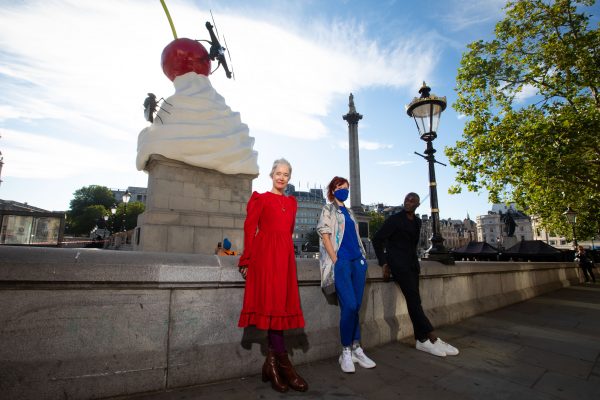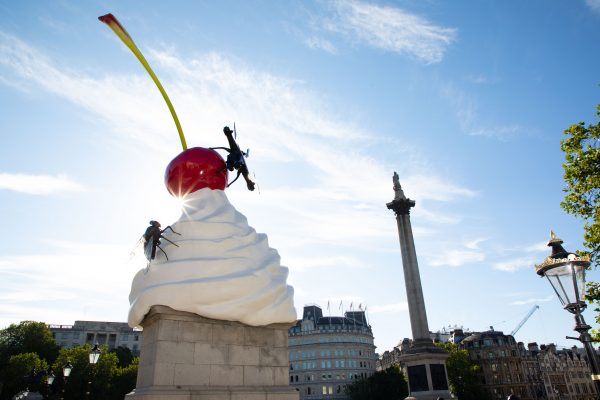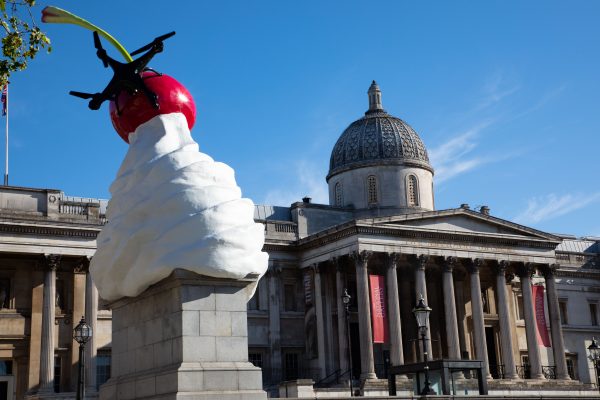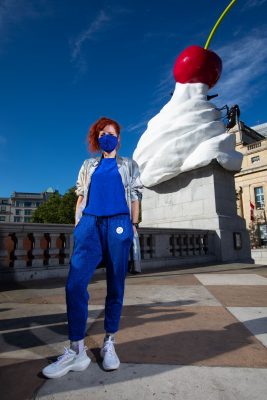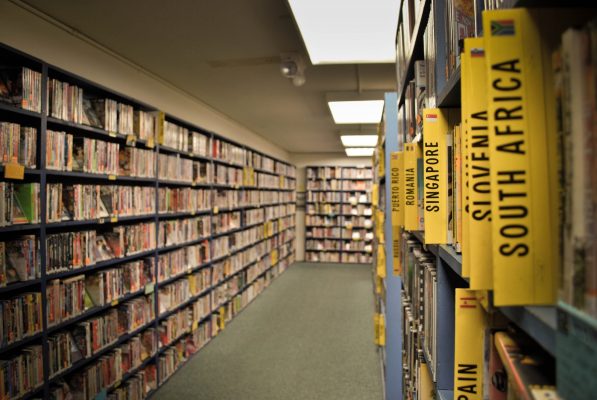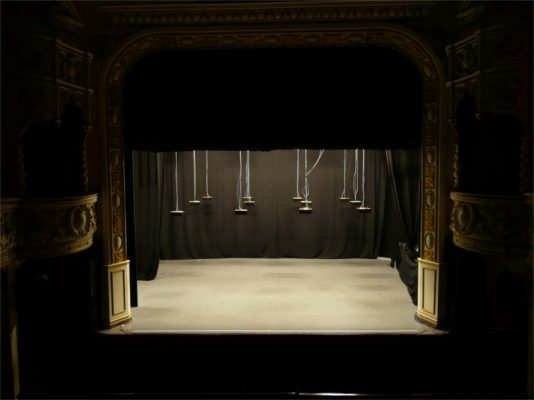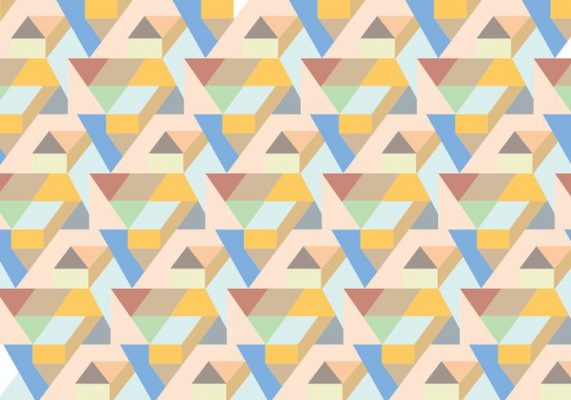A huge swirl of whipped cream, garnished with a drone, a fly, and a maraschino cherry: so insistent that I avert my eyes on purpose, like how I won’t look at strangers revving the engines of bright convertibles. Still, each time I circle the traffic-choked drain of Trafalgar Square on my bicycle, I can’t avoid it. It squirts into my consciousness an airy sugar, a heady fume.
Heather Phillipson’s The End (2020) is the Fourth Plinth’s latest topping; since 1998, the public art project has invited contemporary artists to respond to the square and its monuments. The project has resulted in a number of meditations on imperialism, such as Yinka Shonibare’s Nelson’s Ship in a Bottle (2010) and Michael Rakowitz’s The Invisible Enemy Should Not Exist (2019), as well as middle fingers to the patriarchy, as with Katharina Fritsch’s giant blue Hahn/Cock (2011). Hans Haacke’s skeletal, riderless Gift Horse (2015), its front legs wrapped in stock market ticker-tape, embodied the vulture-pecked wealth of the city’s dead centre. Invoking themes of surveillance and empty excess, Phillipson doesn’t break from this cynical tradition. The piece was conceived and commissioned in 2016, the year that finally dug the grave of American exceptionalism with Donald Trump’s election, and of the European project with the Brexit referendum; the year that Phillipson says she ‘lost her sense of humour’ to despair. Hence the titular fatalism of The End, in spite of its ludicrously pop encasement. 2020’s cascading disasters, and the attendant strain placed on public consensus and societal cohesion, have only clarified Phillipson’s worst instincts, turning The End into a portent of a precarious era.
Phillipson initially planned The End for Trafalgar Square’s everyday atmosphere of touristic fantasy and formalised dissent, intending instant pleasure with a top note of subversion. But on March 16 — the eve of the first nationwide lockdown, coinciding with The End’s scheduled unveiling — the square’s protesters, buskers, tourists, and gaggles of teens evaporated as if on the spot. Four months later, the sculpture was revealed to just a handful of journalists and municipal aides, and, for a time, towered ludicrously over nothing but hungry pigeons. Trafalgar Square has been irregularly populated once more in the months since then — by anti-masker demonstrations, commuters on foot, locals out crushing tinnies after the 10 p.m. curfew, and the tails of mass Black Lives Matter protests gathering outside Parliament or in Hyde Park — but it’s undeniably emptier, a shell that was once a locus. I know this because the drone positioned parasitically on the sculpture’s cherry isn’t purely decorative; it feeds a livestream of the square’s activities to an encrypted website. A pointless gesture, one could say, given the myriad cameras trained on Trafalgar Square — handheld or CCTV — at any given moment, and London’s reputation as a highly policed citadel where, infamously, you can be captured on cop cameras up to 300 times in one day. The End contains visual echoes of England’s smallest police station, too, located just across the square. After plainclothes policemen failed to break up a popular demonstration following World War I, an ornate light fixture in the southeast corner was hollowed out enough to conceal one officer and a direct line to Scotland Yard. If the handset left its cradle, the cherry-pip bulb atop the plinth would blaze alight, alerting every officer in the vicinity to come running. Today, the station is just a closet for maintenance staff, long forced into obsolescence by dozens of CCTV cameras perched and swivelling outside the embassies, the galleries, and the monuments themselves.
The drone features in The End as a false enemy, included to help activists subvert surveillance, and not the other way round. In an interview with Juliet Rix, Phillipson describes the machine as one that returns, rather than removes, agency, inserting a breath of self-perception between the networked spying of peers and state. ‘I wanted the viewer to be able to be in the square and to have an aerial perspective on it at the same time,’ she says. ‘When you’re protesting, you’re often deep inside it, in a crowd, and you can’t see the scale or the edges. I wanted to offer back a bit of agency — to be able to view as well as be viewed.’ It’s the drone’s animal mirror, a monstrous fly sucking up cream below, who notifies us that something rotten’s afoot, a creature already bloated with historic and contemporary symbolism. In Dutch and Italian paintings from the 14th to 17th centuries, a finely-painted fly meant death and deception; if it circled over a church official or nobleman, it indicated corruption or dereliction of duty, operating as a manifestation of the classic Gramsci adage: ‘in this interregnum, a great variety of morbid symptoms appear.’ In the same spirit, when a fly landed on Republican Mike Pence during the US vice presidential debates on October 7 and clung on for minutes unnoticed, American netizens — their appetites for metaphor already whetted by 2020’s burning skies, rivers of sludge, and the enduring plague — lost their shit. ‘rot, wasting away, decay, death, melancholia,’ tweeted curator Antwaun Sargent over zoomed-in footage of the insect caught in Pence’s white hair.
It was the Vice President’s hair, so lacquered and white it looked like a prop under TV studio lighting, that brought me back to The End, with its fake foam and resin cream and conspicuous fly. Up close, the cream appears freshly gessoed, as unnaturally white as toothpaste or icing sugar. It’s garish, retro, certainly squirted from an aerosol can ready to be repurposed for whip-its; in no world has it been lovingly whisked to stiffness to be piled on pavlova. It is food without nutrition; unsanctimonious pleasure; the distillation of hundreds of thousands of banana splits, garnished with gravity-defying cream and cherries, slid across faux-marble countertops in the Cheesecake Factories of the world. It recalls Claes Oldenburg and Coosje van Bruggen’s sculptures of mass satisfaction, such as Spoonbridge and Cherry (1988), which arcs over a man-made Minneapolis river, or Dropped Cone (2001), the overturned ice-cream cone on the vertex of a Cologne shopping mall, the latter described by van Bruggen as a ‘cornucopia of consumerism’ and a ‘sign of transience.’ But in the context of 2020, such victual pleasures are acrid with political poignance. The same October of Pence’s fly, the UK Conservative Party attempted to justify defunding free school meals during the holidays for impoverished children after pouring $567 million into the ‘Eat Out to Help Out’ restaurant subsidy scheme, enabling those with the means to enjoy table service at slashed prices. The announcement triggered fierce online debate, where silver-spooners insisted it was easy to feed a family with £2 and a roast chicken carcass, and entitled for the underclasses to want otherwise. Many of these squabbles reheated points from years past, when the UK government attempted to ban cheap, unhealthy meals in the name of curbing obesity — while the wealthy remained free to thicken their waistlines with Iberico ham and fatty wagyu. Class divisions are often most vividly illustrated and enforced by access to food; by emulsifying cheap food with methods of spying and control, The End inadvertently distills the whole melee.
The relation between drone, fly, cream, plinth, and cherry is relatively concise for Phillipson, who has a maximalist tendency: grasping worldly cacophony with molly-addled sensitivity and stuffing it, in all its sensory richness, into gallery rooms. Images, found objects, sculptures, and soundscapes intermingle, skittering associatively in every direction, and her four collections of poetry expose how her work is governed by an illogic of relation. ‘Slouched like a bleeding ulcer / on a thirsty highway, I saw larvae collecting around the pre-rotten innards. I saw my physical make- / up, proportions balanced like an aerated chocolate bar with mint polyps. It wasn’t easy to breathe, / as usual,’ reads a section of her poem, Guess What? (2015), psychedelically bleeding between subjectivities, zooming in and out of scale. Her almost Ashberian sensibility invites multiple readings and expansions. One clue from Phillipson — that the cream is firmly of the whipping, not soft serve, variety — sends me down a rabbit hole and to Chantilly, where it’s alleged that Louis II’s butler invented the confection to mark the Sun King’s arrival at Vaux-le-Vicomte. The banquet was a bust, or so the story goes, and the butler, in shame, suicided, his death lending us an economical parable about the cruelty of aristocracy and the futility of appeasing it. Left to the rich, frivolity is often dangerous, buttressing inequity in the name of pleasure. The desire for voluptuousness — to relish the cream expelled onto the tip of one’s finger; to take time to luxuriate rather than produce to consume — is good only when it’s for everyone. As Anne Boyer writes in The Undying (2019): ‘Those who diminish the beauty and luxury of survival must do so because they have been so rarely almost dead.’ Or as New Orleans trans activist group BreakOUT! called in 2016 and waited for the world to answer: ‘Give us roses while we’re still living.’
In a year of compulsory isolation, consenting (and non-consenting) surveillance, and the widening abysses of social division, The End appears as a surreal omen of a dissolving ‘public.’ A momentarily perfect, precarious unity of fat and air, whipped cream is a colloid, a volatile assemblage in itself. ‘It’s a hyper-real form, buoyed up by air, that can only retain its shape for a limited period,’ says Phillipson. ‘Exposed to touch or heat, it collapses.’ In his trilogy of works on the human condition, Bubbles (2011), Globes (2014), and Foams (2016), the philosopher Peter Sloterdijk uses the colloid of foam as an extended metaphor for human society, building up a thesis of foundational togetherness to counter the Heideggerian insistence that humans are fundamentally alone — as a conscious species among animals, as individuals among each other. The womb and its amniotic fluid, Sloterdijk postulates, is the original bubble of existence, circulating sustenance seamlessly between two bodies. Once exited, he writes, it’s sorely missed, which is why we’ve replicated it, imperfectly, in the myriad ways we seek to live and survive. From friendships to families to corporations and institutions, and now, even the tiny ‘Covid bubbles’ of trusted peers, these discrete bubbles don’t exist in de facto consensus. They’re separate but engulfed by a tenuous suspension. The foam, in other words, signifies the fragility of social cohesion. Sloterdijk intends it as a warning: under the strain of unchanging imparity, its time may soon be up.
